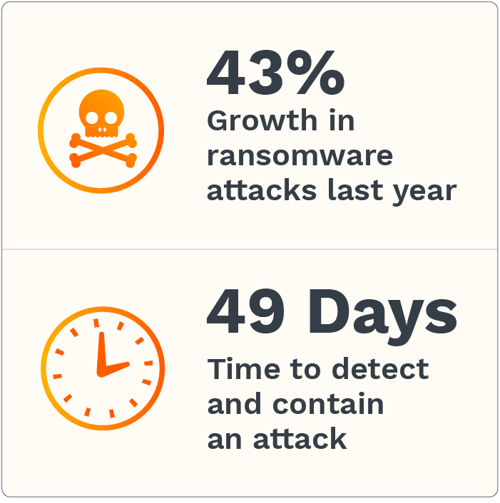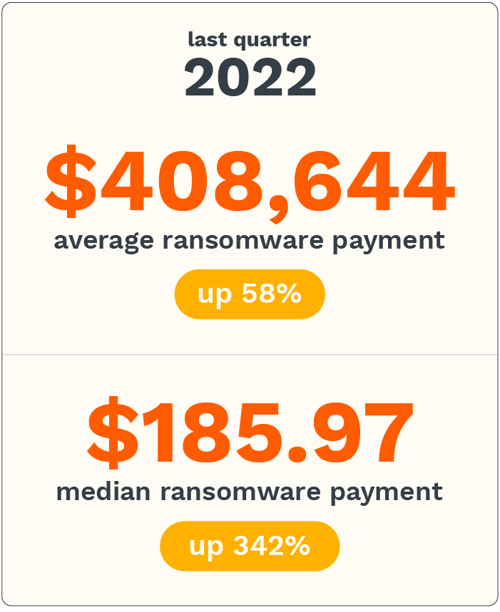In today's hyper-connected world, cybersecurity is critical for business relevance. In the current threat landscape, cybercrime is prevalent, and everyone is a live target and should respond accordingly. This makes it vital to secure enterprise infrastructure with robust cyber defenses with the help of a managed security services provider.
With the emergence of cryptocurrencies, cyberattacks evolved into malware-powered ransomware attacks. Today, ransomware gangs leverage data infiltrations and the threat of data leaks to force companies to make large ransomware payments.
Even if an organization is prepared for a ransomware attack and is able to restore data and operations from backups, its sensitive data can appear on the dark web and be sold on illicit marketplaces operated by cybercriminals.

What's troubling is the fact that ransomware attacks grew by as much as 43% last year and took more than 49 days to detect and contain. As such, it's safe to assume that ransomware costs will also increase as it takes too long for identification and remediation.
According to IBM’s cost of a data breach report, the top three industries targeted by hackers in 2022 include the following:
Healthcare
The healthcare industry is an attractive target as it stores oceans of sensitive personal and medical data. The average data breach costs $10.1 million to recover from, but many are known to cost a lot more. For example, the data security costs related to a ransomware incident at Universal Healthcare Services added up to $67 million.
Education
The academic sector accounted for 30% of the data breaches last year, with an average data breach recovery cost of $1.58 million for lower secondary education. Higher education had an average recovery cost of $1.42 million.
Government
Verizon reported a rise in what they call "actor disclosure" in 58% of data breaches. In this scenario, an actor can be either someone working inside or a third-party company. The rise in the number of ransomware attacks has been attributed to geopolitical issues.
What Is a Ransomware Attack?
A ransomware attack involves an attacker encrypting a company's data using malware and demanding a ransom payment for the decryption key. Whether or not a business pays hefty ransom payments, these security events usually result in significant financial losses.
According to Verizon's Data Breach Investigation Report (DBIR), 2022 saw a 13% rise in ransomware attacks year-over-year, a more significant increase than that in previous years combined. The average cost of a ransomware attack is now approximately $4.54 million. This can be devastating for small businesses.
Some notable victims of ransomware attacks include Cisco, the San Francisco 49ers, the Los Angeles Unified School District, the Costa Rican government, Nvidia, and the Colonial Pipeline, to name a few.
What are The Costs of A Ransomware Attack?
According to IBM’s data breach report, the global average data breach cost is $4.35 million. But, surprisingly, the average cost of a data breach in the United States is much more, almost $5 million more, at a whopping $9.44 million.
Ransom Payment Costs
The ransom payment demanded by ransomware groups is the most apparent cost of a ransomware attack. Ransomware demands can vary depending on the specific business, industry vertical, and data type. But typically, this type of extortion leads to ransomware payments in the thousands and even millions.

However, the average ransom payment in the last quarter of 2022 was $408,644 (up 58% from the previous quarter). The median ransomware payment skyrocketed by 342% to $185.972 over the same period.
Threat actors usually demand payment in cryptocurrency to make it harder to trace, and this has made the ransomware threat more prevalent. However, paying ransoms comes with zero guarantees. After all, you're dealing with ransomware gangs, and there is no way to know that they will actually decrypt enterprise data after receiving the ransom payment. As such, the overall ransomware recovery costs can take some time to calculate.
Data Loss Costs
If an organization is unable or unwilling to bow down to the threat actor's ransom demands, it may lose access to all its encrypted data. This can be catastrophic for organizations that rely heavily on digital assets. Loss of important client information, intellectual property, and financial records can result in significant financial losses and damage to a company's reputation.
Data loss costs are more complex. We can break down data loss costs into the following categories:
Direct Costs Associated with The Loss of Critical Data
Data loss can directly impact overall operations, including a company's ability to provide essential services to customers. For example, losing valuable data, such as customer or operational data, can disrupt business processes and impede decision-making.
Costs Associated with The Loss of Intellectual Property
The loss of sensitive information, such as trade secrets, proprietary technology, or research data, can have severe long-term consequences for an organization's competitiveness. Competitors may gain an unfair advantage if they gain access to stolen intellectual property.
Unforeseen Data Recovery Expenses
Ransomware recovery costs can be significant. Recovering from a ransomware attack isn't straightforward. If data backups are readily available, organizations may still need to invest time and resources to quickly restore lost data.
For example, businesses may have to absorb expenses related to hiring data recovery experts and buying new hardware to store recovered data. If an organization needs to decrypt oceans of data, it can cost thousands of dollars.
In some cases, organizations may have to rebuild their IT systems altogether, which can take weeks or even months. As your business won't be able to ensure normal operations during this period, it will undoubtedly result in the loss of productivity, revenue, and brand value.
Lost Revenue and Opportunity Costs
Downtime and a lack of business continuity can have far-reaching consequences. For example, critical data loss will almost certainly lead to lost business opportunities and decreased revenue. When enterprises struggle to serve their customers effectively, fulfill orders, or pursue new business ventures without access to essential data, it will negatively impact brand image. In this scenario, downtime costs and ransomware payouts to cybercriminals can have a crippling impact on businesses.
Loss of Customer Trust and Loyalty Costs
Data breaches often lead to a loss of customer loyalty and trust. This is especially true if personal or sensitive information is compromised in a ransomware attack. The loss of trust can result in decreased customer retention, difficulty in acquiring new customers, and a significant impact on the organization's bottom line.
Potential Legal and Regulatory Costs
Data breaches are expensive. Whether it’s a small business or a corporate giant, regulators consistently hold organizations accountable for ransomware attacks and data breaches.
Depending on the nature of the security event and the jurisdiction in which the organization operates, there may be legal and regulatory consequences for failing to protect sensitive data. This can result in compliance violation costs in the form of fines, penalties, and potential class action lawsuits.
The True Costs
The long-term impact of a ransomware attack and potential data breach can last months or even years. This is because data lost or encrypted in a ransomware attack can impact a company's growth and development. In fact, it may take a lot longer than anyone would like to rebuild lost data, rebuild customer trust, and restore normal business operations. This can affect the organization's market position and future business relevance.
In conclusion, the true costs incurred as a result of a ransomware attack can be significant. It accounts for direct costs, such as ransom payments, legal fees, compliance violations costs, and ransomware recovery costs, and indirect costs, like the loss of productivity and reputational damage, and rapidly rising cyberinsurance premiums.
Taking proactive steps is critical to preventing these attacks from happening in the first place. This includes investing in robust cybersecurity measures and having a solid disaster recovery and incident response plan in place. It will also help to sign up for cyberinsurance to reduce the impact of a cyberattack.
By doing so, businesses can minimize the risk of these costly events and ensure the ongoing effectiveness of their operations.
Categories: Security, Network Security, Cloud Computing Security, Email Security, Data Breach, Cyber Attack, IT, Cybersecurity, Ransomware











